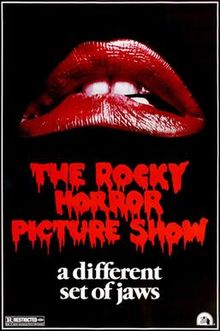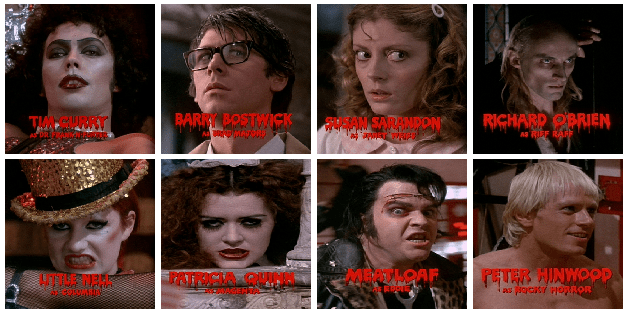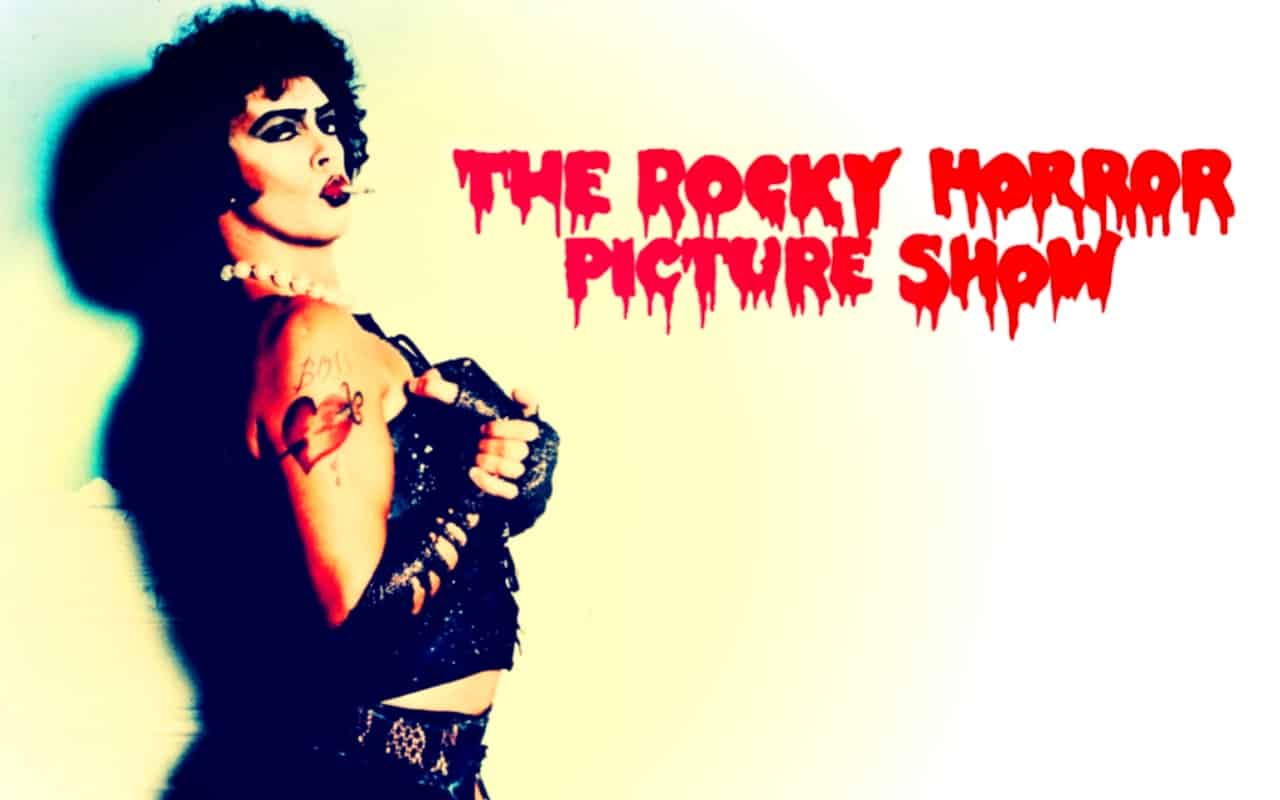
Directed by Jim Sharman
Screenplay by Richard O’Brien and Jim Sharman
1975, USA
The Rocky Horror Picture Show isn’t the first midnight-cult-classic, but the beautiful, weird and dark musical is without a doubt, the most famous. The film celebrates its 40th anniversary this week and so what better time to add it to my list of greatest cult films.
For the unfamiliar, The Rocky Horror Picture Show is the film adaptation of a popular musical stage production composed and written by Richard O’Brien, a struggling actor at the time who was best known for his performances in such musicals as Hair and Jesus Christ Superstar. For O’Brien, The Rocky Horror Picture Show was an homage to drive-in double features and science fiction B-movies of the fifties, and ironically, the film itself went on to become the ultimate midnight movie. TRHPS opened Sept. 26, 1975, advertised with the iconic poster of a set of lips and the catchy tagline “A different set of jaws.” The film was critically panned on release by most movie critics, and more-or-less tanked at the box office. But soon, word got out that it centered on a singing transvestite alien and people began to take an interest. Rocky Horror then gained popularity when it resurfaced on April 1, 1976, at the Waverly in New York City, with sold out midnight screenings every day of the week. A regular following of enthusiasts returned to the cinemas frequently and they quickly learned every line, hop, skip and beat — and when audiences began participating along with the film, everything changed. The film itself is an entertaining romp, but the audience-participation phenomenon is what sets TRHPS apart from every other film on the planet. If you’ve seen it with a crowd than you know just what a one-of-a-kind cinematic experience it truly is. To this day, screenings held in and around its anniversary as well as on Halloween sell out. It has never been pulled by 20th Century Fox from its original 1975 release, and it continues to play in cinemas four decades after its premiere, making it the longest-running theatrical release in film history. It was selected for preservation in the US National Film Registry by the Library of Congress in 2005 and has become the official definition of a cult movie.

The story sees recently engaged Brad (Barry Bostwick) and Janet (Susan Sarandon) stranded on a stormy night in the middle of nowhere. In search of refuge, they walk through the rain to a nearby castle to call for help. The castle’s servants welcome them in to meet their master, Frank-N-Furter (Tim Curry), a cross-dressing extraterrestrial hosting the annual convention of aliens from the planet of Transylvania. Frank-N-Furter is working on a machine that will make him the perfect boy toy, a handsome fellow named Rocky (Peter Hinwood), and insists Brad and Janet stick around to witness his scientific experiment come to life. Brad and Janet quickly find themselves in danger of the menacing hunchbacked Riff Raff (Richard O’Brien) and his crazed sister Magenta (Patricia Quinn). Meanwhile, the mad scientist Frank isn’t above taking advantage of his new guests, nor murdering his old pal Eddie (Meatloaf), a motorcycle rock singer, who returns to life briefly to sing a classic rock ‘n’ roll number
Rocky Horror is a slice of unadulterated fun – but it’s also a groundbreaking and important film when taking into account its sexual themes and the relentless array of gay iconography. It’s a musical spin on Frankenstein about two clean-cut squares who never stepped outside their safe zone until one day they happen to cross paths with Dr. Frank N. Furter and his strange circle of friends. At first, Brad and Janet are terrified but once they get to know Frank and his entourage, it changes them forever and opens their minds.
The film opens on the iconic image of big bright red lips before cutting to an aerial view of a cross on top of a church. As the camera pans down toward the front of the church, a wedding ceremony as just concluded and the married couple proceed with the traditional throwing of the bouquet. Janet catches the bouquet and from here Brad proposes to her because, well, that is what people were expected to do – get hitched, settle down and have kids. But it is clear that Brad and Janet hardly know each other (later we learn Brad doesn’t even know her last name) and it is more than clear that these two aren’t even in love. Brad begins his proposal by pointing out that it will help him in getting a job promotion and advance his career and by the end of his proposal, Brad’s true motives become clear. The straight-laced couple represents the American, white middle-class Christian boy and girl and we are blatantly reminded of their status for the entirety of the film. Brad is confident and cocky, placing his arm around Janet and assuring her that he will keep her safe, leading Frank-N-Furter to sarcastically remark, “How forceful you are Brad, such a perfect specimen of manhood.” Meanwhile, Janet is the girl-next-door type; innocent, shy and reserved. Frank-N-Furter, is something completely different, acting out whatever sexual and aggressive urges he has without worrying about what others think. Throughout the movie, Frank-N-Furter dresses in drag and theatrically reenacts the roles from well-known movies in order to act out his sexual fantasies. Early in the evening, he has Brad and Janet stripped to their underwear and sent to separate beds for the night. He then enters their rooms in disguise and seduces both Janet and then Brad in two identical scenes draped in silhouette. RHPS takes multiple stabs at the traditional concept of love, not only through the pre-marriage cheating of Janet and Brad but also through the relationship Dr. Frank N. Furter has with his object of affection, Rocky. The juxtaposition of heterosexual traditions and the events that take place at the mansion, clearly questions traditional gender stereotypes and sexuality, but The Rocky Horror Picture Show is meant to stress more than issues of queerness. The message is not that marriage is wrong, but it is calling the institution of marriage into question along with monogamy and the close-minded view many Americans have that your either gay or straight and there can’t be anything in between. Although Dr. Frank-n-Furter is a man dressed as a woman, he has sex with men and women and when the film ends, it is unclear how any of the characters sexually identify themselves — gay, bi, curious or straight?

The Rocky Horror Picture Show helped to open the conversation on issues of sexuality and gender, demonstrating that gender roles and stereotypes are socially constructed and that everyone would be happier if conformity was no longer the norm. But more than that, some would argue that the movie also addresses female empowerment. When we first meet Janet, she’s soft-spoken, polite, appears weak, and easily faints and screams at the sight of Frank and his minions. Just after their car breaks down Janet jokes about Brad running off with a beautiful woman, indicating that while she has somewhat of a sense of humour, she’s also insecure about her role in their relationship. Ironically, it is in fact Janet who cheats on Brad first and does so again when she seduces Rocky in her very own musical number. Janet is sexy, but she doesn’t know she is at the start of the film — but it doesn’t take long before the passive aggressive type becomes the complete opposite. In her sex scene with Rocky, it is Janet, not Rocky, who becomes the active seducer. The scene completely sidesteps the active erotic male gaze we are accustomed to seeing in motion pictures and instead, we get the female gaze as the muscled beauty falls under her spell. Furthermore, we also witness two women watching the act through hidden cameras as they themselves reenact the scene as it’s happening. While Brad is undone by his exposure to the debauchery and gall of Frank-N-Furter, Janet is set free. As a result of her unusual experience, she doesn’t grow to be as confused and bitter as Frank-N-Furter nor as conservative, as she and Brad were when they first arrived. Janet walks away from the ordeal a more open-minded, and some would argue, happier person.
When the original stage show production debuted in 1973, it was the start of the end of the glam rock movement and Doctor Frank-N-Furter’s journey heavily mirrors the politics and taboos that accompanied glam rock at the time. Rocky Horror is crammed with multiple callbacks to Golden Age sci-fi and horror movies, and TRHPS had as much to say about music as it did about sexuality. After Rocky is brought to life, the audience is introduced to Eddie, a former lover of both Frank and Columbia. Eddie seems innocent and sweet, but Frank sees him as a threat. We quickly learn that half of Eddie’s brain was cut out in sacrifice to the doctor’s creation via transplant, and now that he’s back, Frank wants him gone. Eddie’s song “Hot Patootie — Bless My Soul” harkens back to the beginning of rock’n’roll — and so when Tim Curry’s Frank chases after Meatloaf’s Eddie and butchers him with an axe — Frank isn’t killing a man so much as he’s standing in for how many people believed that glam rock was killing classic rock n’ roll. The Rocky Horror Picture Show after all is a musical, first and foremost and a celebration of music. Anyone who says TRHPS isn’t good for gays because Frank is a murdering, narcissistic, emotionally manipulative sociopath is missing the point. Take Frank-N-Furter on his own: his persona borrows heavily from David Bowie’s creation of Ziggy Stardust, about a bisexual alien rock superstar sent from another planet. Ziggy Stardust represents the definitive rock star: sexually promiscuous, wild in drug intake but with a message, ultimately, of peace and love. He is destroyed both by his own consumptions and by the fans he inspired. Frank and his creation make a perfect metaphor for what glam was all about.
The movie reaches its thematic climax as Frank-N-Furter uses his alien technology to transform a number of the characters, including Brad, Janet and Rocky Horror, into versions of himself before Frank-N-Furter sings the movie’s theme song in a swimming pool scene reminiscent of a Busby Berkeley musical. After enduring physical, verbal and mental abuse by Frank-N-Furter, Riff-Raff and Magenta turn heel and abort their alien mission shooting Frank in the chest and leaving Rocky to carry his near-dead-corpse away like Kong handled Fay Wray’s Ann Darrow. As Riff tells him, “it’s all over. Your mission is a failure. Your lifestyle’s too extreme.” In the end, Frank-N-Furter is assassinated for his sins; the spaceship lifts off, and Brad, Janet, and the other survivors are left crawling around disoriented in a fog of uncertainty. They are left changed and confused, but their future is bright. Before the credits role, we are left with a message:
“Lost in time. Lost in space… and meaning.”
The Rocky Horror Picture Show is a gaudy pastiche of B-movie science fiction and horror like no other. Everything from eccentric shooting angles, vibrant colors, cheap sets, cheap props, flamboyant costumes, and bright lighting fits perfectly with the overall tone of the film. Nearly every frame, every angle, every cut works despite the film’s many technical flaws. The set pieces are cheap, the props childish, the choreography is wonderfully out of sync — the film dialogue is clumsy and the acting is suspect, but the magic of Rocky Horror is emphasized by the fact that its creative team, writer/composer Richard O’Brien and director Jim Sharman were working on a low-budget with limited resources. They did what they could with what they had and the result is something truly special. Rocky Horror is a prime example of the right people working together at the right time and working out ways to create something without ever giving up. There had never been — and, since its release, never has been — a movie like The Rocky Horror Picture Show. It isn’t something you can recreate, remake or try to imitate, although many of tried. The outrageous rock musical has become a staple of the pop culture scene and a one of a kind cult masterpiece. Curry’s energetic performance, is worth the price of admission alone. Some say that Tim Curry’s best role is a toss up between his portrayal of Nigel Thornberry in The Wild Thornberrys and Pennywise the Clown in Stephen King’s It, but it was The Rocky Horror Picture Show that made the man a star. This is the character that people associate Curry with most, and it’s easy to see why. Tim Curry’s transvestite creature-creator Frank N’ Furter goes down as one of the greatest antagonists in any movie, and because of Curry’s incredible performance, Dr. Frank N. Furter became an LGBT icon. Bravely donning fishnet stockings, suspenders, high heels and a face full of white powdery makeup, Curry’s performance as the lingerie-clad mad scientist is nothing short of brilliant.
I could go on, but 2500 words for a movie 40 years old is already too long, so let me end with this: Many critics regard it as more of a social phenomenon than as a great movie, but I would argue that The Rocky Horror Picture Show is a masterpiece.

